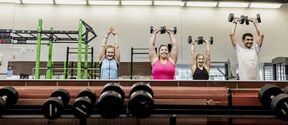Moral reflection can be seen in brain activity and eye movements

Social neuroscience researchers investigated the effects of similarity by showing subjects the film My Sister’s Keeper and asking them to watch the film from either the perspective of the donor sister or the sick sister. The subjects' brain processing was measured by functional MRI, and at the same time eye tracking was carried out, monitoring where the subject’s eyes were looking on the screen.
‘Understanding another person’s point of view is important to reach consensus. It can reduce prejudices and facilitate the development of empathy. We wanted to find out how taking and changing perspective is reflected in brain activity and eye movement,’ said Postdoctoral Researcher Mareike Bacha-Trams.
The study involved 30 women who were shown a 25-minute clip from the film My Sister’s Keeper, and who were asked to observe the film from different perspectives. There is a moral conflict in the film where Anna refuses to donate an organ to her sister Kate who has cancer.
At the beginning of the film, the researchers told the subjects that the sisters were either biological siblings or that the younger sister had been adopted into the family as a baby.
‘When the subject watched the film from the perspective of the organ donor sister, this activated the brain areas where moral thinking occurs. When the viewer watched the clip from the perspective of the sick sister, more of the brain areas were activated which have been found to be involved in empathy and sympathy. Different areas of the brain can be used flexibly as needed,’ said Professor Iiro Jääskeläinen.
The viewer’s assumption on whether the potential organ donor and the sick sister were biological siblings confirmed the differences in brain activation and eye analysis between different perspectives.
‘Based on the eye tracking analysis, it was found that when the subject watches the film from the perspective of the potential organ donor, they look more at both protagonists than the subject who has been following the film from the sick sister’s point of view,’ Mareike Bacha-Trams said.
At the same time, all subjects looked more at the sick sister than the donor sister.
‘The sick sister is the object of compassion. Following her gestures, facial expressions and body language generated empathy,’ Mareike Bacha-Trams added.
Mareike Bacha-Trams has recently received Marie Skłodowska-Curie funding and a Kone Foundation grant for her research. Each grant is for three years. This summer, Dr Bacha-Trams will transfer to a researcher position at the University of Helsinki, and as part of her studies intends to research fake news from a neuroscience perspective. Dr Bacha-Trams will also continue to study social neuroscience. The next study will look at who the subject would save when they have to choose between two faces, and one has been made to resemble themselves.
Further information:
Article: Social perspective-taking shapes brain hemodynamic activity and eye movements during movie viewing
Read more news
Apply to be a guest professor or visiting researcher at the Université Grenoble Alpes
Unite! partner, Université Grenoble Alpes (UGA) has opened a call to host international professors and researchers for short stays.
Many new things at UniSport this spring - see what’s coming!
The new year at UniSport starts energetically and brings plenty of new offerings for Aalto University staff and students – including pilates at Undergraduate Centre, plans for the Viikki sports centre, a free challenge, and much more.
Postdoctoral researcher Eloi Moliner makes history as a 5-time award winner
Eloi Moliner is one of the most decorated doctoral researchers in Aalto University's history – we would like to highlight his success and contributions to the field of audio signal processing






